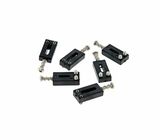Although these saddles are pitched at Mexican Stratocaster owners (hence the name), I bought these to use with a Squier Bullet Mustang, and I highly recommend them.
The problem:
The Squier Bullet Mustang model has (rightly, in my opinion) garnered a reputation as a fantastic budget guitar. However, one of the few common complaints with it is the bridge system. Basically, this is a Strat-style hardtail bridge, which was designed for use with a long-scale (64.8cm) guitar and a string-through-body design. However, the Bullet Mustang has a short scale (61cm) and top-loads its strings (similar to a Telecaster). Consequently, it has a lower string tension and a less acute break angle, causing two undesirable results: saddles that rattle around on top of the bridge (which is at best an annoyance, and at worst will put your strings out of tune), and intonation problems resulting from the intonation screws sometimes pressing on the end of the string.
The theory:
String Saver saddles are built a bit bigger and wider than the stock Squier saddles (lots of alliteration there). This should create more lateral tension across the bridge, i.e. the saddles will push sideways against each other and keep each other in place, thus solving the rattle. Moreover, the intonation screw can travel further into the saddle without pushing on the string, therefore avoiding the intonation issue.
The method:
Getting the String Saver saddles up and running was a breeze. Take off the strings, remove the intonation screws from the stock saddles, and get them off the bridge. Then simply reverse the process using the String Savers (remembering that the spring fits over the intonation screw between the saddle and the tail of the bridge, so that it pushes the saddle up towards the nut, or else it won't work). Finding the right string action is pretty straightforward using the supplied hex key to adjust the vertical screws on each saddle. Having screwed in the intonation screws until the tips were flush with the saddles, I found that I barely had to make any adjustments at all in order to get perfect 12th-fret notes. Of course, that may differ wildly from one guitar to another.
The results:
The String Savers are an upgrade on the stock saddles in almost every way. The rattle issue is solved, the saddles no longer move when under tension, and there is a healthy amount of daylight between intonation screw and string in each one. Moreover, the tops of the new saddles are considerably flatter and smoother than the stock ones. When playing a guitar with a hardtail, I tend to rest my hand on the bridge for greater pick control and ease of palm-muting, and I found that the stock saddles could be a bit sharp and irritating (not enough to be painful, but enough to be an unpleasant distraction). The String Savers have no such issues, so playing is now much more comfortable – a lovely unexpected bonus. I also haven't noticed any compromise in the tone; I have seen some Strat owners commenting that it took away some of the treble, but this hasn't been an issue on my Mustang (though this might be due to the guitars' different characteristics rather than the saddles as such).
The verdict:
It might seem counter-intuitive to buy a budget guitar and then spend almost a third of its value again to upgrade the saddles, but it is money well spent. The String Savers have been an improvement on the stock model in basically every way – so perhaps it's better to think of it as the Squier's tiny pricetag giving you extra budget to spend on some great saddles.


